Dolphins, Rainbows and Unicorns…A Princess Diary of The Whanganella Banks
- Lori Tanner-Somers
- Apr 27, 2019
- 11 min read
Updated: Nov 25, 2023
Three hundred nautical miles to the northwest of Cape Reinga, New Zealand, lies the hallowed Whanganella Banks, an underwater seamount , where the ocean floor rises from the depths of 3000 meters to an incredibly shallow 50 meters. The cool currents of the Tasman sea are pushed up as the waters reach the banks, concentrating large masses of food and bait. Hungry striped marlin take advantage of this natural phenomenon, and school in great numbers at certain times of the year to feed. There have been reports of double digit hookups in a single day from recreational boats such as Destiny and Bwanna II, frequent visitors to the Bank. The remote location of the Whanganella Banks face little pressure from both sport and commercial fishing and have proven to be some the most productive striped marlin grounds in the world, perhaps only second in numbers to Magdalena Bay, Mexico. To a New Zealander, the Whanganella Banks is the Holy Grail of striped marlin fishing.
It’s our forth excursion to the Whanganella Banks aboard November Rain, our 56’ sport-fishing long-range catamaran. Our first trip to the Banks, a year ago to the date in 2018, earned us 12 released fish over three days, out of a staggering 58 strikes. While it was a good trip, we hoped we could do better. Since then, we have had two additional passes at the Banks, both on circuitous routes taken while travelling to Vanuatu and from Australia. Neither of those trips were very productive, netting only one fish for each pass. Recent reports from regular visitors to the bank were promising big numbers and Gaz, my partner in crime, was chomping at the bit to make a return visit. Of course, weather was and alway is the biggest obstacle, finding a pattern that will promise 10 knots or less for at least a week, with prevailing winds pushing us in the right direction. Secondly, a tougher obstacle perhaps, is finding able-bodied anglers that can step up a moment’s notice without fear of job consequences or marital strife. Easter week was shaping up as a perfect convergence of good weather and free time, and after a few frantic texts, emails and phone calls between mates, Gaz stitched together a 6-man crew for another off-shore adventure. He also made arraignments with another boat from Whangarei, No Worries, to buddy boat and remain in radio contact while on the bank. It’s beneficial to have extra eyes out there on the vast expanse of water, one; to help located the fish, and two; for safety reasons, the nearest help being over 300 miles away.
The four mates arrived from Auckland by car to Whangaroa Harbour, where November Rain was berthed, armed with one too many frozen spaghetti dinners (poor communication on my part), beef casseroles, bacon and egg pies and at least 2 kilos of ginger candy,… just in case. Gaz and I had stocked up the live bait well with some large jack-macks that we had harvested in the harbour earlier in the day. Bunks and life jackets were assigned, safety briefings performed and night watch shifts parceled out at two hour intervals to our experienced crew.
Thirty-six hours later at our cruising speed of 9 knots, we coasted onto the southern part of the Bank, right on daybreak. I was on shift and as the sun rose, the radio silence on the VHF was shattered by animated chatter between two boats already on the bank. Bwana II and No Worries, both motor catamarans, were comparing notes about the previous day’s fishing as I eagerly eavesdropped. Bwana reported tagging seventeen fish the previous day on the Bank. No Worries, having arrived after dark the evening before, and had yet to drag a line. Bwana advised No Worries that the marlin were taking black and purple, lumo and pink colored lures. After a bit, Bwana noticed our AIS signal and made radio contact with us, welcoming us to the party. They turned their AIS off of “stealth” mode, and suddenly, we could see their location on the chart plotter. They had been fishing the northern end of the bank the previous day and had been trying to make their way south, but kept getting “interrupted” by all the action. Gaz offered that we would scout out the southern location and report back.

Gaz, from his perch on November Rain’s tuna tower

Birds on a meatball
Captain Gaz was scanning the horizon from the tuna tower shortly after dawn, and almost immediately, spotted the signs of fish, flocks of birds, mostly mutton ducks (sooty shearwaters), bobbing on the surface with their heads under water, a clear sign of bait just below the surface. We trolled four lures past the first meatball and immediately got a double strike, landing our first striped marlin by 7 am. It was complete and utter madness for the next twelve hours. With five anglers, four of us were geared up with buckets and harnesses at all times, prepared to jump on a rod. And boy, did we do a lot of jumping! We ran a rotation, each angler standing by a rod as Gaz drove past meatballs. We all took turns at wiring fish, often more fun, exhilarating and potentially dangerous than angling marlin, also, a position subject to more verbal abuse from the flybridge.

Grant starts off the action with the first fish

By 9 am, we had already released nine marlin. After a particularly messy quadruple strike, Gaz opted to go down to trolling just three lures. Three times that first day, we had double hook ups with double successes. Gaz would nominated a fish that he felt we could bring in first, while the second angler would waddle up to the bow, dejectedly watching the 37 kg nylon top shot disappear off the reel, often down to the Dacron backing. If the second angler was in danger of getting spooled, someone would signal Gaz, who would then run the boat forward to regain line, before returning to fighting the first fish who’s line he had just run off of. Double hook-ups can take three times as long to land as a single hook-up can.

Grant on the wire with a feisty one
Interestingly, there were schools of large dolphins feeding all around us and they seemed somewhat interested in watching us, occasionally doing aerial flips to get a better view of us. Several times, our jaws dropped in amazement as dozens of striped marlin, lit up with their brilliant blue pectoral fins and iridescent violet stripes, corralled meatballs of bait right alongside the boat. We were close enough to have free tagged them, had we been bothering with a tag pole and tags. Dark skippy showers danced across the horizon, parting open by beautiful rainbows curtains hanging from the sky, making the scene surreal. Dolphins, rainbows and dozens of unicorns. …yes, this was a magical place for this princess.

Glenn admires the rainbows
The other two boats on the Bank made their way down to our neck of the woods when they learned about our early successes and joined in the fun. The bite was on all day, and by sunset, the five anglers aboard November Rain had released a total of twenty-seven striped marlin. The fish was in excellent and fat condition, with many over 180 kgs in estimated weight, or in fisherman’s terms, “It’s a HORSE!”. The bite was hot, the fish were committed when they struck, and we estimated that we hooked, caught and released one out of every three strikes, a much better rate for us than our previous pass to the Bank a year ago. We made only one change in our gear from the previous year, and that was to change the orientation of the single hook on the cut-face lures from our standard pointing upward to a downward facing position. It’s a theory Gaz has on how the fish take the bait on the Bank. Whatever, it seemed to be working.

Bwana II (foreground) and No Worries
A few mistakes were made and a few lessons were learned; we ran over one line with the propeller while fighting a double hook-up and lost the fish. Another fish, foul-hooked in the pectoral fin, took a good hour and a half to drag to the boat-side and Murray had to take a concrete pill to harden up his quivering gelatin thighs. Grant discovered a swivel clip that had bent completely open while wiring a fish, but amazingly, did not lose the fish, or more importantly, one of Gaz’s favorite lures. I pulled the hooks on the next fish, and oddly enough, the swivel on that one was bent right open as well. Bent swivel clips proved to be our Achilles heel and we had several more incidents over the next few days, and lost another fish and a lure as a result.

The fish can fly and the birds can swim
One of our early catches, a particularly angry fellow, slashed the side of the boat hard enough to snap off his bill before sulking away, seemingly confused at his new perspective. Another fish presented herself with a weird pom-pom of mussels growing out of her forehead, looking a bit like she was wearing a fancy party hat. The wireman tried to remove the growth, but it became apparently that it was permanently attached, and we could even see more mussels inside the roof of the fish’s mouth. Our best guess was that the shellfish farm had attached itself to an old fishing line that had penetrated the roof of the mouth and had never been properly removed.

The girl with the Pom Pom Party Hat
At night on the Bank, after dinner, we would shut down the twin engines, activate the radar alarms and bob around like a cork, adrift, some of us enjoying twilight sleep, others tossing in their bunks. The first morning, Gaz discovered that we had drifted 14 miles off the fishing grounds and we wasted an hour of daylight making our way back. Our live baits had not lasted the first night, someone had accidentally switched off the water pump, and so sadly, they were laid to rest in the freezer, recycled as pitch baits.

Sunset on the Whanganella Bank, Number 27 for the day
The second day, it became obvious to us that the marlin were less committed on the bite, but then again, so were our anglers. The lactic acid of the previous day’s workouts was beginning to burn and there were plenty of aches and pains to moan about, reducing the enthusiasm to jump on a rod. Our hook up rate dropped considerable as well, to about 1 out of 6. The swell was a bit bigger than the day before, and if a fish decided to run up sea, you just knew you were going to get soaking wet. Gaz decided that we were not going to try for multiple hookups anymore, as it was just too hard on the angler who’s fish was not nominated to chase first. As soon as we had a hook up, the other gear was quickly reeled in. We dropped more fish the second day, but still had productive numbers, ending with a total of ten fish to the side of the boat for release. A radio conference between the captains of the other two boats on the bank brought the total of the Bank to 37 fish for the day. The previous’ days total was over 51 fish for just three boats! Over 100 fish in three days for the three boats!

Destiny, a frequent visitor to the Whanganella Banks,
The third morning, a forth boat, Destiny, arrived to the party. She’s a big old steel trawler, and a probably has more time and experience on the Bank than any other recreational boat around. We trolled around all morning, but the birds and meatballs of bait were becoming scarcer. We still managed to hook up and release three stripeys, one of them well over 200 kgs, and possibly a contender for the World Women’s All Tackle Record. Gaz chose not to harvest the fish, given that it would be at least 48 hours before we could weigh it, making the meat inedible and a waste. The afternoon continued to be slow until Toby on Bwana radioed us over this his quadrant, counting three meatballs boiling up around him. So nice of them to share! Gaz raced over at 15 knots and we picked up another four fish in the two hours before dark, with several double strikes causing a lot of pandemonium and chaos on the deck. Eventually, the fish wised up and lost interest in chasing lures, but continued to feed on the surface bait, causing us a lot of frustration. We tried pitch baiting some of our dead solders, but had no luck. Seven fish for us on day three, tying with our best record day in New Zealand, and bringing our total up to 44 fish released over the past three days with only one day to go.

Lori’s big fish, estimated at over 200 Kgs
Somehow, the boys got it in their heads that 50 was the magic number that we needed to achieve, but as the forth day wore on, it was beginning to look more like a mythical number. Several strikes early in the morning failed to materialize, then the first solid hookup fell off at the 20 minute mark. Our first catch on the board was around 11 am, and we didn’t see another fish until 4 pm. Coming to believe this might be our last opportunity, a decision was made to harvest the next fish. As the boys went up to the bow locker to retrieve the flying gaffs, the leader was suddenly within reach and I grabbed my gloves. As a female with small hands, I have tried and failed to find professional wiring gloves in my size. Normally, I improvise by wearing a pair of fingerless leather sailing gloves underneath a pair of rubber reinforced work gloves, providing me with good grip and protection, but I was short on time, so I grabbed only the top layer. I was able to get a good wrap and began pulling the fish up and towards the side of the boat. Unfortunately, the fish was still green and suddenly took off deep, cinching the leader around my four fingers, crushing my hand. I screamed out in pain, and one of the guys was able to grab the leader from me before the gaffs went in. A bag of frozen peas from the galley was sacrificed to my broken pinkie finger. (If a gear manufacturer is reading this, I beg that you start paying attention to the female anglers, there are more of us than you think, struggling to find big-game gear that fits our smaller frames. And maybe I wouldn’t have to finish this report by pecking it out with my left hand.)

Purple is the in color
Once the fish was hauled aboard, lines went back out and we immediately had another triple strike, landing yet another fish out of the three. The bite was back on and the boys fished hard in the last hour before dark to reach the magic number. Every angler had caught ten fish each, save myself at nine, before my injury. Gaz stepped down from the helm to wind in the 50th fish, enduring taunts from the crew, such as “wind, wind, wind” and other insults, while Andy, on the helm, bore criticism from Gaz about his driving skills.

Harvested striped marlin on the deck, the one that broke my finger
High fives, hand shakes and kisses were passed out by the Captain (okay, so only I got the kisses), to celebrate our accomplishments over the past four days. As the boys were butchering the 110 kg carcass on the back deck, multiple reels screamed off again. We ending up catching two more fish in the dark, as the anglers tried to avoid slipping on the bloody mess on the deck. The last two fish brought up the total tally to fifty-two striped marlin, more in four days than we normally catch in an entire year!

Grey hounding action
The following morning, the carnage to our gear was assessed. The rods we fish with are a combination of Kilwell and Shimano 37 kg straight butts, coupled with Tiagra 80 reels, spooled with 37 kg nylon top shot spliced on to 37 kg Dacron backing. We suffered one broken reel clicker, four busted hooks with an additional two straightened right out, and lost three lures, including two of our Red Gills, (one on its’ maiden run). As we continued motoring southeastward towards home, and to the horror of the exhausted crew, Gaz tossed two lines out behind the boat. Who knows, maybe we’ll stumble across a blue marlin out in the deep. After all, there are no fences out there.

Andy shows off a custom Bonze lure from Harkin Boatbuilding that was a real hit with the stripeys






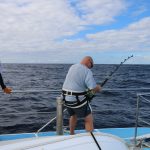
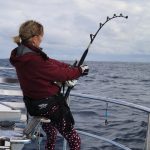
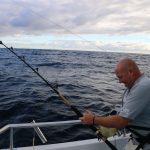
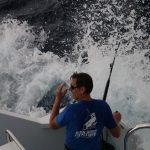

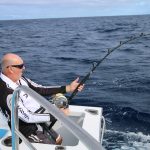

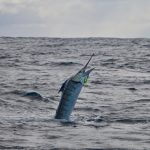
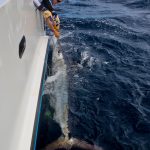
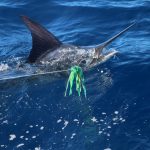
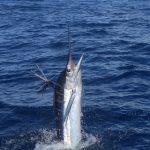
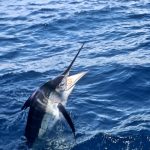
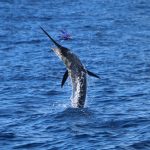
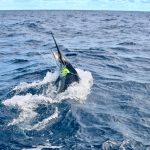



Comments